
Lace is a delicate fabric made of yarn or thread in an open weblike pattern, made by machine or by hand. Generally, lace is divided into two main categories, needlelace and bobbin lace, although there are other types of lace, such as knitted or crocheted lace. Other laces such as these are considered as a category of their specific craft. Knitted lace, therefore, is an example of knitting. This article considers both needle lace and bobbin lace.
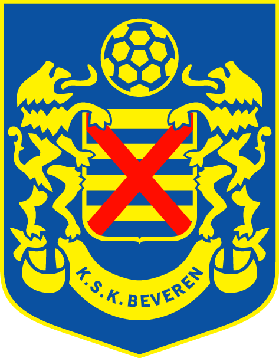
KSK Beveren is a Belgian football club from Beveren in East Flanders with founded number 2300 and with yellow and blue as colors. The club became national champion twice in its existence and won the Belgian Cup twice. The men's branch of the club was temporarily discontinued in 2010, until 2022 only the women's team played at the Royal Belgian Football Association under founding number 2300. In 2022, after an agreement with Waasland-Beveren, the founding number was released again for men's football, so the club has been active since the 2022-23 season again with a men's team. KSK Beveren is the first football club in Belgium that is completely controlled by supporters and is bound by the principles of Supporters Direct.
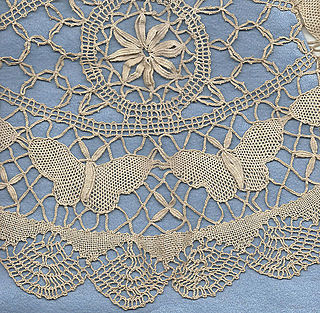
Guipure lace is a type of bobbin lace. It connects the motifs with bars or plaits rather than net or mesh.

Limerick lace is a specific class of lace originating in Limerick, Ireland, which was later produced throughout the country. It evolved from the invention of a machine which made net in 1808. Until John Heathcoat invented a net-making machine in Devon in 1815, handmade net was a very expensive fabric. This meant cheap net became available to Irish lacemakers, particularly after 1823 when Heathcoat's patent expired.
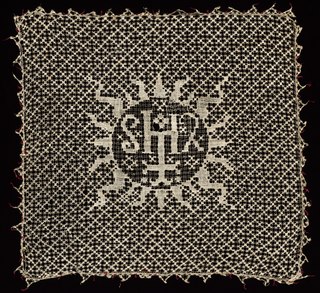
Buratto is an Italian needle lace made by darning on a net. It is quite similar in appearance to filet lace but with one important distinction—it is darned onto a woven net, rather than the knotted net used for filet. Buratto tends to also be heavier in appearance due to the woven nature of the netting used

Tambour lace refers to a family of lace made by stretching a fine net over a frame and creating a chain stitch, known as tambour, using a fine, pointed hook to reach through the net and draw the working thread through.

Needlerun net is a family of laces created by using a needle to embroider on a net ground.
Robert Charles Bell (1917–2002) was the author of several books on board games, most importantly Board and Table Games 1 & 2. This work won the Premier Award of the Doctors' Hobbies Exhibition, London. He was instrumental in popularizing traditional games, and is acknowledged as one of 11 "principal sources" in David Parlett's The Oxford History of Board Games.

Cluny lace is a bobbin lace style, worked as a continuous piece. It is a heavy plaited lace of geometric design, often with radiating thin, pointed wheatears. It is a guipure style of lace.

Renaissance lace is a type of tape lace. The name refers to the rebirth of antique Italian forms to create the patterns of this 19th century lace.

Part lace or sectional lace is a way of making bobbin lace. It characterises various styles, such as Honiton lace or Brussels lace.

Russian lace is a bobbin tape lace. The tape is made with bobbins at the same time as the rest of the lace, curving back on itself, and joined using a crochet hook. It was made in Russia, but similar laces made elsewhere are also called Russian lace.
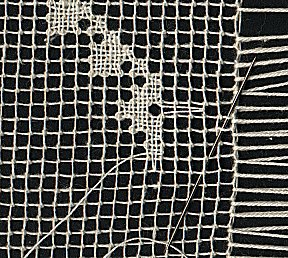
Embroidered lace is embroidered on a base using a needle. The base varies according to the type.
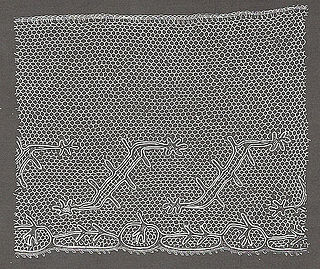
Lille lace was a type of bobbin lace that was made at Lille, also known as Rijsel. It was a lightweight lace popular in the eighteenth century in both black and white. It lacked the rich designs of Valenciennes lace. Its quality declined after the French Revolution, and by 1800 it was worn only by 'the most ordinary women'. In the first half of the nineteenth century the sketch-line designs, made only of gimp, were enclosed by a cloudy fond simple, relieved only by a scattering of tiny dots. After the French Revolution of 1848, little was made commercially.
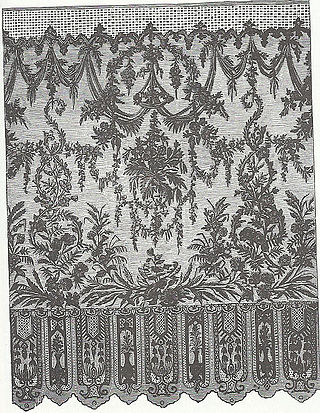
Bayeux lace was bobbin lace that was made at Bayeux in Normandy, France.

Mesh grounded lace is a continuous bobbin lace also known as straight lace. Continuous bobbin lace is made in one piece on a lace pillow. The threads of the ground enter motifs, then leave to join the ground again further down the process, all made in one go. This is different from part lace, where the motifs are created separately, then joined together afterwards.

Point de Paris is a French bobbin lace of the 18th century, with slender trailing designs in a point de Paris ground. It was a simple lace, and did not compete with those of Flanders. It was revived in the late 19th century for trimming lingerie and 'fancy linen'.

Flanders lace was made in Flanders, which was particularly well known for its bobbin lace. The supreme epoch of Flemish lace lasted from about 1550-1750.
Bobbin lace ground is the regular small mesh filling the open spaces of continuous bobbin lace. Other names for bobbin lace ground are net or réseau. The precise course of the threads and the resultant shape of the ground are an important diagnostic feature in lace identification, as different lace styles use different grounds.



















